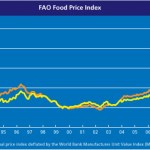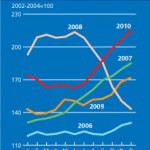food crisis
Yesterday was World Food Day, and NPR has a good piece about the role of speculation in food prices:
The economists argue that increased trading is a significant part of the reason grocery prices are higher this year.
And grocery prices are indeed up this year. For example, in August, the average price of bread in U.S. cities was up 17.4 percent over last year, while milk was up 12.4 percent, according to the latest report from the Bureau of Labor Statistics.
Brandon Kliethermes, an agriculture economist with the forecasting firm IHS Global Insight, agrees that speculators do increase…
Last year at the 2010 ASPO conference (and over the years at other places) I've highlighted the connection between oil prices and food prices - and the ways that our increasingly tightly tied oil and food systems unravel together. If you missed these graphs last week, they'll give you the beginnings of the picture, but I can show you a few thousand more. In every conceivable way, we have worked to tie energy and food prices together - from our increasing reliance on globalized markets and shipping to our fertilizer dependence, to our growth in biofuel usage, to centralized meat production…
From the UN FAO, we can see that world food prices remain extremely high. We also, I think, when we conjoin this with oil prices can see that there is at least a significant correlation.
So much of what has been done in agriculture over the last 75 years has served to tie oil and food prices more tightly together, but it is increasingly clear that the world's poor cannot afford to have their access to food controlled by the price of energy on world markets. That kills people, to put it as bluntly as possible.
This is one of the reasons I'm least convinced that improving agricultural…
The USDA indicates that in 2010 there were above 17 million households in the US (out of about 115 million households total) that were food insecure, and had trouble getting enough food on a regular basis. Only 59% of those households, however, received Food Stamps, WIC or School lunches, the three largest US food subsidy programs that make up the bulk of US nutritional supplementation programs. Which means that nearly half of all households were either receiving no support despite food insecurity, or relying on food pantries, soup kitchens and other resources.
One of the most significant…
Mark Notaras has a great review of the UN's World Food Program on the links between food insecurity and conflict:
Brinkman and Hendrix point out that the relationship between food insecurity and violent conflict is not one way. High food prices are both exacerbated by and exacerbate the chance of civil unrest. In other words, food security is a pre-condition for political stability and political stability is a precondition for food security. The question of what came first is perhaps not as relevant as attempting to understanding how to escape what Collier and his colleagues refer to as the…
First, check out my guest post at Scientific American Blogs as part of their "Passions of Food Day" Blog Fest.
Also, just keeping you all updated (as much as I can within the confidentiality guidelines), we got our first call about a foster placement, in this case a group of five children. It isn't clear that we would be asked to take all five - we might be asked to take 3, 4, or 5, depending on different possible scenarios. It isn't at all clear whether we would take all five children (which is more than we hand planned to accept, although we do feel strongly about keeping siblings…
In January of 2007, Aaron Newton, my friend and co-author of A Nation of Farmers came to Albany for four days of intense work on our book. We barely ate, slept or left the house, since we knew it would be the only chance the two of us had to hash everything out. Perhaps the single most intense moment for me, at least, was the conversation Aaron and I had about the central chapter of the book - the one that answered the question "Can we actually feed the 9+ billion people expected to live on this planet without lots of fossil fueled inputs?" This was the question answered by Tuesday's…
If you want to see it in color, all you have to do is google image up a history of the price of oil and superimpose it on the price of various staple crops. Take a look at oil and then rice, soybeans, wheat and corn. Look closely at 2008, and at the present. I will put up a visual presentation of this material myself later this week, but if you'd like to see it sooner, it is right there to look at, no great challenge.
What we see is fairly simple - and incredibly complicated. The intertwining of markets, of energy and food, tied by biofuel production and national policies, and the fact…
This is a lightly revised and updated version of a piece that ran at ye olde blogge and at Grist, but it seems just as pertinent now as it did in 2007 when I wrote it. At the time, some people doubted that the boom we were seeing in biofuel production, which was pushing up grain prices, would be followed by any kind of a bust. Farmers were predicting many, many good years - but we all know what happened. Farm incomes dropped by more than 20% during the recession. Just another reminder that busts are part of the boom and bust cycle, no matter how little we like to admit it.
There is no…
Stuart Staniford has a terrific piece that offers a little visual clarity about food, energy, unemployment and the Riots in the Middle East and North Africa:
Tunisia is a minnow in the global oil market, Egypt slightly more important. Algeria, however, matters a lot as its oil production is probably close to total demonstrated OPEC spare capacity. Thus serious social instability in Algeria would have major effects on global oil prices. If instability spread to bigger oil producers than that (eg Kuwait or UAE), the effects could be very dramatic.
Presumably, the regimes in those countries…
A number of readers asked me to comment on the recent Argentine report that predicts disaster for world food supplies based on Climate Change in the near term. I hadn't done so because I was honestly puzzled by the report, which got a lot of attention, and raised awareness of climate food issues, but seemed to be predicting a much greater degree of near-term warning than is likely, barring extreme climate forcings. I was a little surprised to see such a comparatively obscure report get so much attention, when in fact, more reputable analyses have been largely ignored.
I'm grateful then that…
The Food Crisis, of course. In fact it really never left - since 2007 we've had more hungry people on the planet than ever before in human history, and while we've seen brief declines in the numbers of the hungry worldwide, those declines were of such short duration that they were essentially meaningless - earlier this year when the UN trumpeted that the number of the hungry had dropped back below 1 billion, it admitted that this excluded Pakistani flood victims, the impacts of the crisis in the Russian wheat crop and a host of other late-year issues.
On the lists of guests no one ever…
The UN Food and Agriculture Organization has released a new Food Outlook, and the news isn't great.
Global wheat and rice production have both suffered setbacks this year as Russia has suffered from drought and Pakistan from floods. Poor cassava harvests in Asia are also a concern, given that cassava is the staple food of nearly a billion people. Tight supply has caused prices to rise for these and other food commodities.
The fear is that we'll face another global food crisis like the one that caused riots in several countries in 2008. The FAO suggests it's not time to panic yet, but a little…
Remember the global food crisis of 2008? Disappointing wheat harvests in Europe, the US, and Australia led to a shortfall in global supplies, and poorer countries and consumers couldn't afford grain that had suddenly become much more expensive. In the US, families struggled to stretch their food budgets; in 14 other countries, food-related violence erupted.
Memories of that recent crisis have stirred as Russia (which suffered from drought this summer) has banned exports of its wheat and other countries have faced droughts or flooding. After the cost of bread jumped 30%, riots broke out in…
Thanks to reader Sunshine for forwarding me this AP article, which I think does a really good job of pointing up something I've been talking about for a long time - the food crisis that was in the news two years ago never actually went away. While food prices stabilized in the developed world and things like the economic crisis shoved the situation of the poor and hungry off the front pages, that doesn't mean the food crisis came to an end.
With food costing up to 70 percent of family income in the poorest countries, rising prices are squeezing household budgets and threatening to worsen…

